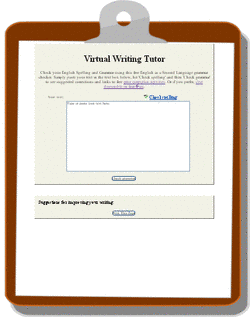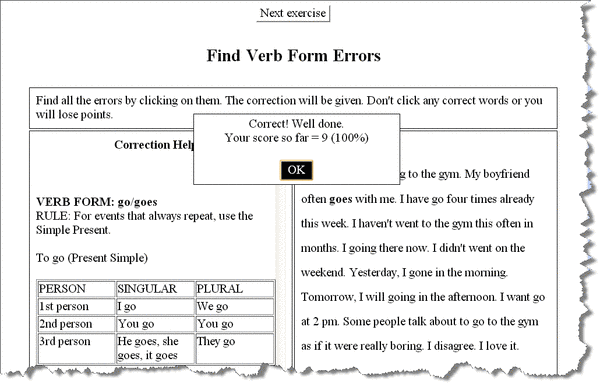The Virtual Writing Tutor
As a teacher of English as a Second Language, I have been interested in developing computer-assisted error correction because it promises a number of benefits :
- An improvement in the quantity or frequency of corrective feedback
- An improvement in the timeliness of the corrective feedback
- An improvement in the quality and detail of the corrective feedback
- A reduction for teachers in the time and tedium involved in correcting large numbers of assignments.
Disappointingly, Microsoft Word, Grammarly, GingerSoft, and WhiteSmoke all seem designed primarily to catch first language (L1) writing errors. As such second language (L2) writers are underserved by these systems because of the high error density in their L2 writing, so Melvin Shantz and I launched VirtualWritingTutor.com, a free online grammar checker for ESL learners – made possible by the generous financial support of Tango Publications.

The Virtual Writing Clipboard
Quantity and Frequency of Corrective Feedback
The usual way to provide 101 students with corrective feedback on their “structured writing,” is typically to assign two essays, one at the midterm and one later in the course, and require two drafts of each essay. The first draft gets detailed corrective feedback, and the second draft then gets a grade and further feedback justifying the grade. In the process, students apply revision strategies twice a semester and get personalized instruction on grammar, word choice, usage, mechanics, spelling, and argumentation.
With fewer students, teachers would probably be able to give more feedback or assign more than two essays in a semester. However, by automating some of the feedback teachers provide their students and making it available online 24/7, students could get more feedback more frequently. It is a fine idea, provided the extra feedback is of a suitable quality.

A Correction on the Clipboard
Timeliness of Corrective Feedback
To provide the range of feedback on surface errors that a human ESL teacher can bring to bear on a piece of L2 writing, I estimate that an auto-correction system will need about 3000 error-detection rules with about 1500 exceptions. At the time of writing, the Virtual Writing Tutor had over 2100 rules and 1000 exceptions in place.
A student text that would normally take a human teacher from 5 to 20 minutes to correct and a week or more to return to the student takes our server only 56 milliseconds to process and just a second to return to the student.
Quality of Corrective Feedback
But speed is not everything. By taking corrective feedback off of paper and putting it on the computer screen, every time a student submits a text with an error to the Virtual Writing Tutor, the system returns a detailed message about the nature and location of the error. Unlike hand-coded essays, errors are not identified by a two or three letter correction code that the student has to look up on a correction key, nor does the student have to decipher the teacher’s handwritten comments in the margin. Instead, a detailed message identifying the nature and location of the error, along with suggestions for correction and a link to remedial help and online resources.
The Virtual Writing Tutor returns two kinds of links with its corrective feedback. First and most commonly, a link to a correction practice activity is provided. The reason is that prompting a learner only once to correct a writing error will likely not be enough practice to stick in the learner’s memory. By linking to online activities, the Virtual Writing Tutor aims to provide the extra error correction practice needed to help the learner eliminate the error from all subsequent writing.

By linking to online activities, the Virtual Writing Tutor aims to provide the extra error correction practice needed to help the learner
The second kind of link points to online thesaurus or dictionary entries or other useful resources on the web. For example, if a student submits a text containing the word “nice”, the Virtual Writing Tutor returns this message along with a link to a thesaurus entry :
Learners of English overuse very general content words, which ‘indicates under-use of richer, more precise, and more varied vocabulary’ (Cobb, 2003, p. 399). Try one of these nuanced synonyms for ‘nice’: enjoyable, pleasurable, thoughtful, courteous, lovely, likeable, pleasing, gracious, congenial, cordial, admirable, admirable and considerate. These are just suggestions to get you started. Use a thesaurus and dictionary to find the word that best captures the meaning you want to express. Thesaurus entry
What I hope you will notice from the example above is as follows :
- The VWT is fast, really fast.
- It provides error correction upon demand 24/7.
- It can provide feedback on multiple drafts of text, not just the first and last draft.
- It can explain at length the nature of the error, something human teachers don’t have time or space in the margins for.
- It links to specific resources and remedial activities to help learners eliminate errors from future writing.
- It is available to students and non-students alike, supporting lifelong learning.
The Virtual Writing Tutor is certainly catching on. According to Google Analytics, since April 6582 visitors from over 500 cities in 92 countries have used the website, submitting texts for correction about five times each and spending about seven minutes on the site per visit. So what is next? Apart from writing more error detection rules, what I would dearly like to do is to find a teacher who is willing to compare intact classes, where one class gets hand-coded feedback and another class gets access to the Virtual Writing Tutor. At the end of the course, I would like to compare groups to see if there is any difference in their error density on a final in-class writing assignment. If you or anyone you know is interested in taking part in such a study, please let me know in the comments sections below. As well, if you have any ideas for development or comments about what you see, I will be happy to answer your questions.

